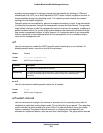
Routing Commands
299
ProSafe M4100 and M7100 Managed Switches
show ip ospf neighbor
This command displays information about OSPF neighbors. If you do not specify a neighbor
IP address, the output displays summary information in a table. If you specify an interface or
tunnel, only the information for that interface or tunnel displays. The <ip-address> is the IP
address of the neighbor, and when you specify this, detailed information about the neighbor
displays. The information below only displays if OSPF is enabled and the interface has a
neighbor.
Format show ip ospf neighbor [interface <slot/port>] [<ip-address>]
Modes
• Privileged EXEC
• User EXEC
If you do not specify an IP address, a table with the following columns displays for all
neighbors or the neighbor associated with the interface that you specify:
Router ID
Priority
IP Address
Neighbor
Interface
State
• Down - initial state of the neighbor conversation - no recent information has been
received from the neighbor
.
• Attempt - no recent information has been received from the neighbor but a more
concerted ef
fort should be made to contact the neighbor.
• Init - an Hello packet has recently been seen from the neighbor, but bidirectional
communication has not yet been established.
• 2 way - communication between the two routers is bidirectional.
• Exchange start - the first step in creating an adjacency between the two neighboring
routers, the goal is to decide which router is the master and to decide upon the initial
DD sequence number
.
• Exchange - the router is describing its entire link state database by sending Database
Description packets to the neighbor
.
• Loading - Link State Request packets are sent to the neighbor asking for the more
recent LSAs that have been discovered (but not yet received) in the Exchange state.
• Full - the neighboring routers are fully adjacent and they will now appear in
router-LSAs and network-LSAs.
Dead Time
Term Definition
The 4-digit dotted-decimal number of the neighbor router.
The OSPF priority for the specified interface. The priority of an interface is a priority
integer from 0 to 255.
A value of '0' indicates that the router is not eligible to become the
designated router on this network.
The IP address of the neighbor.
The interface of the local router in slot/port format.
The state of the neighboring routers. The possible values are:
The amount of time, in seconds, to wait before the router assumes that the neighbor is
unreachable.


















